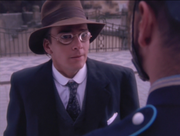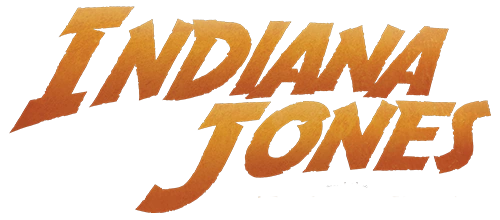- "The man with too many names."
- ―Nadia Kamenevsky, on meeting Indiana Jones[src]
Indiana Jones had earned, used, or been given a variety of names, nicknames, and aliases throughout his adventures. This list of aliases and nicknames sums up the various monikers held by Indiana Jones.
- Actual name: Henry Walton Jones, Junior - Given by his parents, Henry Jones, Sr. and Anna Jones
Nicknames[]
- "We named the dog Indiana."
- ―Henry Jones, Sr.[src]
- Junior - Used by his father, even in Indy's adulthood.[1] After discovering that he had a son in 1957, Indiana Jones jokingly referred to Henry Jones III as Junior.[2]
- Indiana - Taken from the name of his childhood dog, Indiana, often shortened to Indy. Used professionally rather than his actual name.
- Stubborn West Wind (as translated from Tiwa) - Given by the Pueblo native Jay as a sign of his friendship with Jones.[3]
- Mungo Kidogo (meaning "Little God" in Swahili) - Given by Askari soldiers after a battle in German East Africa in which Indy was shot in the chest but resumed fighting seemingly without injury. An unimpressed Remy Baudouin butchered the nickname, calling Indy "Mango-Gorgonzola".[4]
- Jonesy - Used by Paul Robeson,[5] Sidney Bechet[6], George McHale[2] and Helena Shaw.[7]
- Captain Dynamite, Scourge of the Kaiser - Given by Albert Schweitzer in January 1917[8]
- Captain Errand Boy - Used by Indiana Jones to assert his authority over Sixtus of Bourbon-Parma when the prince, a lieutenant, said that he had taken Jones for an errand boy.[9]
Aliases[]
- "What aren't you using your real name? What are you hiding?"
- ―Interrogator in a 1916 Paris police station[src]
- Henri Defense - Created by Indiana Jones when enlisting in the Belgian army, this name served as Indy's official name for his roles in the Belgian military, and later in French and American intelligence, during World War I. It was chosen from "Henry" (his real first name) and "Defense" taken from a sign in the Belgian recruiting office "Defense de fumer" (No smoking).[10]
- Lieutenant Pierre Blanc - An identity appropriated by Indiana Jones after he was captured during the Battle of the Somme. His friend Emile had stolen the uniforms of two dead French soldiers, and Blanc was the man Jones' uniform came from.[11]
- Igor - A name dropped on Jones by Sergei Diaghilev, during Jones's brief cover work as a dancer of the Ballets Russes on its tour of Barcelona, as part of Diaghilev's efforts to ensure that his performers appeared authentically Russian rather than the international mix that they actually were.[12]

Indy posing as Fritz Diefenbaker.
- Fritz Diefenbaker - Cover for Jones in his mission to contact Anthony Fokker in Germany[13]
- Captain Duval - Alias assigned to Indiana Jones while working for French intelligence, as a member of the French Foreign Legion in Morocco in 1917.[14]
- Amadeus Shooblegrueber - Alias assigned to Indiana Jones while working for French intelligence in Prague.[15]
- Nils Anderson - Cover used by Indiana Jones while in Istanbul in 1918 for French intelligence. Nils Anderson was a Swedish reporter for the Balkan News Agency.[16]
- Smith - Cover name briefly provided by Snark to shelter Jones from the Japanese Imperial Army aboard the Kamikaze Maru.[17]
- John Smith - Name Jones gave to the soldiers who captured and imprisoned him in the army's camp below the Devil's Cradle in 1936.[18]
- Lord Clarence MacDonald - Improvised by Indiana Jones while attempting to infiltrate Castle Brunwald with Elsa Schneider (as his lovely assistant) in 1938. Pretending to be a Scottish lord did not work on the Butler.[1]
- Heinrich Widerstand - Jones used this name when purchasing Zeppelin tickets from Berlin to Athens in 1938. Nazi authorities listed this name as a possible alias when making "wanted" pamphlets while attempting to arrest Jones and his father (who used the alias J. Schotte on their flight coupons for D-138). The "wanted" paper also listed Defense and Shooblegrueber as aliases.[19]
- Hank - Jones pretended to be an aviator and fiancé to Bert Brodowski in a ruse to get past some US Army soldiers guarding Brodowski's biplane in Palmar Sur, Costa Rica in the summer of 1941. The ruse nearly worked with the couple pretending to break up and head off to separate planes, until the pilot of the plane that Jones was attempting to enter showed up.[20]
Notes and references[]
- ↑ 1.0 1.1 Indiana Jones and the Last Crusade
- ↑ 2.0 2.1 Indiana Jones and the Kingdom of the Crystal Skull
- ↑ Young Indiana Jones and the Lost Gold of Durango
- ↑ Oganga, The Giver and Taker of Life
- ↑ Winds of Change
- ↑ Young Indiana Jones and the Mystery of the Blues
- ↑ Indiana Jones and the Dial of Destiny
- ↑ Oganga, The Giver and Taker of Life
- ↑ The Young Indiana Jones Chronicles – "Austria, March 1917"
- ↑ Love's Sweet Song
- ↑ "Germany, Mid-August 1916"
- ↑ The Young Indiana Jones Chronicles – "Barcelona, May 1917"
- ↑ Attack of the Hawkmen
- ↑ Tales of Innocence
- ↑ "Prague, August 1917"
- ↑ Masks of Evil
- ↑ Indiana Jones and the Secret of the Sphinx
- ↑ "The Devil's Cradle"
- ↑ The Lost Journal of Indiana Jones
- ↑ Indiana Jones and the Pyramid of the Sorcerer
